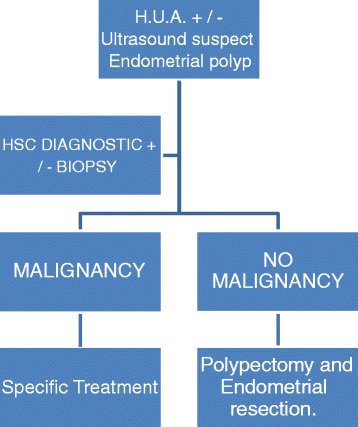Effectiveness of transcervical hysteroscopic endometrial resection based on the prevention of the recurrence of endometrial polyps in post-menopausal women
- PMID: 25783652
- PMCID: PMC4341222
- DOI: 10.1186/s12905-015-0179-0
Effectiveness of transcervical hysteroscopic endometrial resection based on the prevention of the recurrence of endometrial polyps in post-menopausal women
Abstract
Background: The objectives of this study were to determine the effectiveness the effectiveness of post-polypectomy hysteroscopic endometrial resection in preventing the recurrence of endometrial polyps in post-menopausal patients and analyse the complications and necessity of additional surgery in patients, in addition to their degree of satisfaction.
Methods: A prospective longitudinal study of post-menopausal patients diagnosed with endometrial polyps was conducted including polypectomy and hysteroscopic endometrial resection following the therapeutic purposes (endometrial polyp removal) and prevention of recurrence of endometrial polyps. We evaluated the general condition and characteristics of the patients, including age, BMI, smoking habits, medical, surgical, and obstetrics history and menstrual status. The results were analysed at several time points, 6, 18, 42 and 60 months by hysteroscopy, including the presence of vaginal bleeding and/or possible intracavitary pathology.
Results: A total of 89.5% (n = 355) of our patients had profile factors associated with the increased incidence of endometrial polyps and hyperestrogenism (diabetes mellitus, hypertension and overweight); 89.5% (n = 355) of patients were overweight; 34% had grade I obesity. The surgical procedure was safe, with a 90% (n = 357) success rate without complications, which was higher than the 95-99.5% at the beginning and end time points of the study. Patient acceptance and satisfaction was 90 and 84%, respectively.
Conclusions: Endometrial resection proved effective in preventing the recurrence of endometrial polyps. It is a safe and effective method. Post-menopausal bleeding reduces the presence of endometrial polyps. Patients reported satisfaction and acceptance of the procedure.
Figures
Similar articles
-
Pregnancy rates after hysteroscopic polypectomy depending on the size or number of the polyps.Arch Gynecol Obstet. 2008 May;277(5):395-9. doi: 10.1007/s00404-007-0460-z. Epub 2007 Sep 13. Arch Gynecol Obstet. 2008. PMID: 17851673
-
The clinical significance of small endometrial polyps.Eur J Obstet Gynecol Reprod Biol. 2013 Oct;170(2):497-500. doi: 10.1016/j.ejogrb.2013.07.011. Epub 2013 Jul 30. Eur J Obstet Gynecol Reprod Biol. 2013. PMID: 23910695 Review.
-
[Hysteroscopic polypectomy, treatment of abnormal uterine bleeding].Ginecol Obstet Mex. 2015 Jul;83(7):422-8. Ginecol Obstet Mex. 2015. PMID: 26422913 Spanish.
-
A prospective study of the use of the Myosure resectoscope to manage endometrial polyps in an outpatient setting.Aust N Z J Obstet Gynaecol. 2015 Oct;55(5):482-6. doi: 10.1111/ajo.12382. Epub 2015 Aug 11. Aust N Z J Obstet Gynaecol. 2015. PMID: 26259638
-
The risk of malignancy in uterine polyps: A systematic review and meta-analysis.Eur J Obstet Gynecol Reprod Biol. 2019 Jun;237:48-56. doi: 10.1016/j.ejogrb.2019.04.009. Epub 2019 Apr 15. Eur J Obstet Gynecol Reprod Biol. 2019. PMID: 31009859
Cited by
-
Hysteroscopic polypectomy with endometrial resection preventing the recurrence of endometrial polyps: A single-blinded randomized clinical trial.Caspian J Intern Med. 2022 Spring;13(2):393-397. doi: 10.22088/cjim.13.2.393. Caspian J Intern Med. 2022. PMID: 35919639 Free PMC article.
References
-
- Pérez-Carbajo E, Martín-Arias A, Kazlauskas S. Patologia tumoral benigna del cuerpo uterino. Mioma uterino y patología endometrial. In: Bajo Arenas JM, Lailla Vicens JM, Xercanvins Montosa J, editors. Fundamentos de Ginecología. 1ª. Madrid: Editorial Médica Panamericana; 2009. pp. 398–400.
-
- Norris HJ. Preinvasive lesions of the endometrium. Clin Obstet Gynaecol. 1986;13(4):725–38. - PubMed
MeSH terms
LinkOut - more resources
Full Text Sources
Other Literature Sources
Medical


